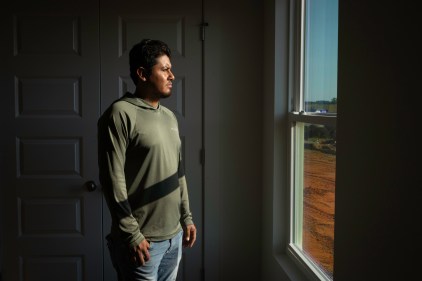In late February, a smuggling boat carrying dozens of Haitians bound for the U.S. was intercepted so close to Florida’s shore that those aboard could see the lights of hotels and passing cars. But although they were in U.S. waters, they have few rights compared to people who arrive at land borders. That’s even true of the three young children traveling alone on that boat, a 10-year-old boy and two sisters, 8 and 4.
I spent months reporting on this group of people, the children in particular, and on the hidden world of immigration enforcement at sea, a border where different rules apply. These are five key findings of the investigation, published last week in partnership with The New York Times Magazine.
Coast Guard detentions in the Caribbean and straits of Florida have reached their highest level in nearly three decades.
Since the summer of 2021, the Coast Guard has detained more than 27,000 people aboard its fleet of cutters in the Caribbean and straits of Florida, more than in any similar period in nearly three decades.
“We are in extremis,” a senior Coast Guard official wrote to colleagues in an email, part of a trove of internal records and data that I obtained. Most of the 27,000 are Haitian and Cuban, people who in recent years have faced extraordinary levels of violence and political unrest. But even people fleeing violence, rape, the threat of death — who on land would be likely to pass an initial asylum screening, according to legal experts — are routinely sent back to the countries they’ve fled when they try to arrive by sea.
The U.S. government has a separate system for people detained at sea to ask for protection. But it is nearly impossible to get through. Of the 27,000 people detained since July 2021, the Coast Guard logged 1,900 such claims, according to an internal Coast Guard database I obtained. Only about 60 of them had those claims approved by the U.S. Citizenship and Immigration Services officials.
Yet even the people whose “fear” claims are approved are not allowed into the U.S. Instead they can agree to be sent to an immigration detention facility on the U.S. naval base at Guantánamo Bay, Cuba, where they’re told they should be prepared to wait for two years or more, until another country agrees to take them as refugees. Only 36 of the people with approved claims since July 2021 agreed to be sent to Guantánamo.
Unlike on land, even unaccompanied children traveling by sea are almost always denied protection in the U.S.
Since July of 2021, the Coast Guard has detained about 500 unaccompanied minors, mostly Haitians. Nearly every one of them was sent back.
On land, unaccompanied minors from countries other than Mexico and Canada cannot simply be turned back. But at sea, children are treated much like adults. Of the 500, only about 1% were allowed into the U.S. because officials determined they would likely be persecuted or tortured if sent back to the countries they fled.
The Coast Guard says that its crew members screen children to identify “human-trafficking indicators and protection concerns including fear of return.” A spokesperson told me that “migrants who indicate a fear of return receive further screening” by Homeland Security officials.
Once children are sent back to Haiti, some face uncertain fates.
No U.S. agency would explain what, if any, precautions the U.S. government takes to protect children, beyond an initial screening conducted aboard cutters.
Our reporting centered on the experience of a 10-year-old boy named Tcherry who, after he was delivered to Haiti by the Coast Guard, left the port with a man he’d met only weeks before at a smuggler’s house. No U.S. or Haitian officials spoke with Tcherry’s mother, who is in Canada, before the man was allowed to leave with the boy. The man himself was surprised how easy it had been.
“When we have custodial protection of those children, we want to make sure that the necessary steps are taken,” a Coast Guard spokesperson said, “to ensure that when we repatriate those migrants, they don’t end up in some nefarious actor’s custody or something.”
But one official from an agency involved in processing people delivered by the U.S. Coast Guard to Haiti told me, “Children leave the port, and what happens to them after they leave, no one knows.”
People are harming themselves in the hopes of making successful asylum claims.
As more and more people have taken to the sea, and their desperation has grown, an increasing number of migrants and refugees have harmed themselves in hopes that they will be rushed to hospitals on land, where they believe they can make asylum claims.
People detained on cutters have swallowed jagged metal cotter pins pulled from the rigging and stabbed themselves with smuggled blades, apparently trying to cause such severe injury that they’d be taken to a hospital. In January, a man plunged a five-inch buck-style knife that he’d carried onto a cutter into the side of his torso and slashed it down his rib cage. Crewmembers now start every leg at sea by scouring the decks for anything that people might use to harm themselves. According to a Department of Homeland Security spokesperson, “medical evacuations do not mean that migrants have a greater chance of remaining in the United States.” But without the ability to claim asylum on cutters, more people are trying anyway.
The rigid immigration restrictions at sea, combined with the nearly 30-year spike in people detained, has created a moral crisis for Coast Guard members, too.
Coast Guard crew members described to me their distress at having to reject desperate person after desperate person. Several people I talked to said that the worst part of the job was turning away the children who were traveling alone. “The hardest ones for me are the unaccompanied minors,” one crew member told me. “They’re put on this boat to try to come to America, and they have no one.”
Crew members were seeing so much suffering, including encountering the bodies of people whose boats had capsized in the sea, that it was not uncommon for them to find each other sobbing. Some were struggling with what one former crew member called a “moral dilemma” because they had begun to understand that the job required them to inflict suffering on others. “We hear their stories, people who say they’d rather we shoot them right here than send them back to what they’re running from,” another Coast Guard member told me. “And then we send them all back.”
The Coast Guard leadership was getting worried: “I don’t see how the current level of operations is sustainable,” the commander of U.S. Coast Guard Sector Miami wrote to colleagues, “without the breaking of several of our people.”
















